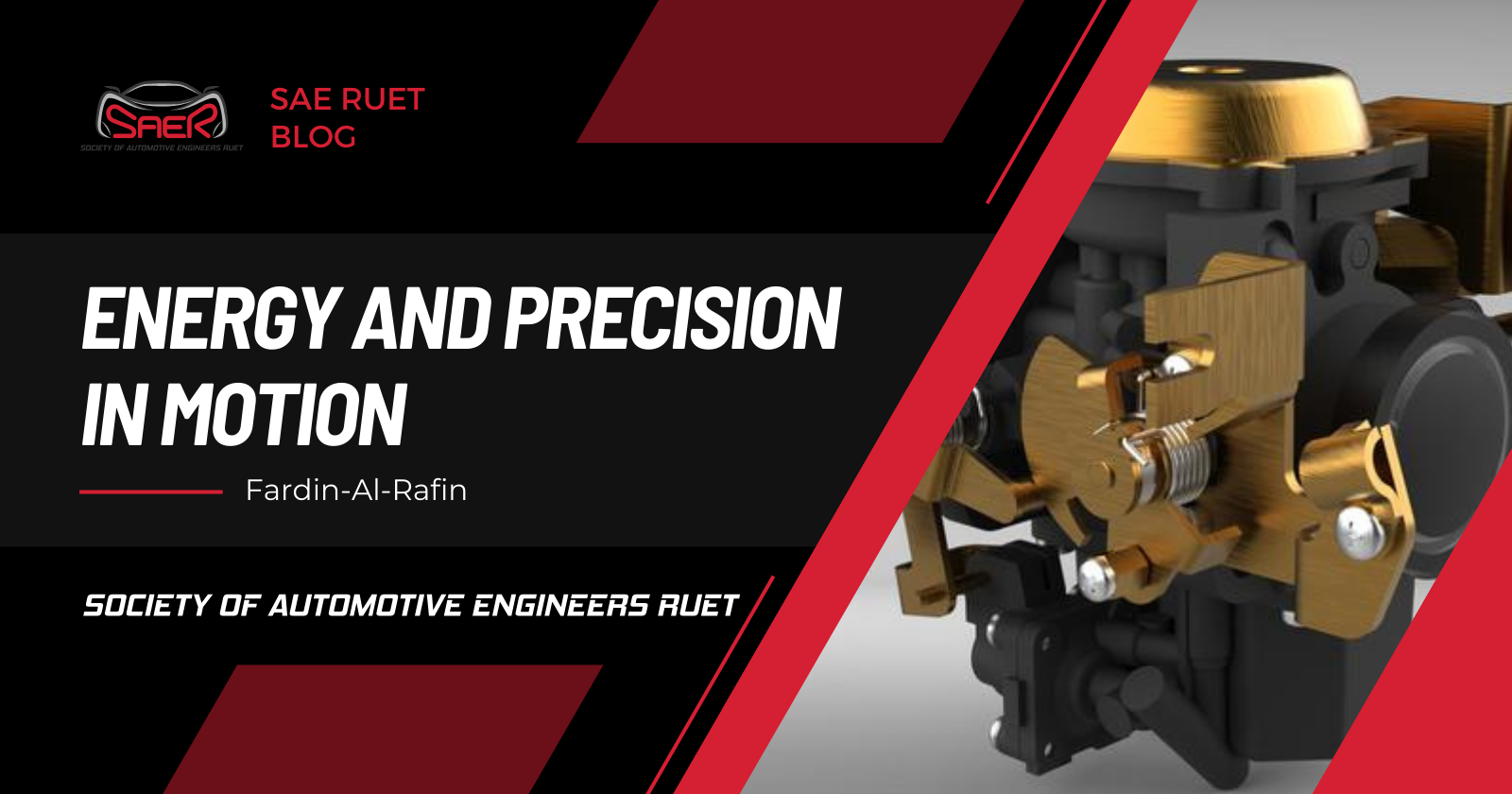Energy and Precision in Motion: Behind the Scenes of Governors, Carburetors and Fuel Injectors
 Society of Automotive Engineers RUET
Society of Automotive Engineers RUET
In this fast-paced world where humans are getting faster and faster by developing more and more efficient machines to ease our lives, there is also a need for precision and accuracy, and without it, there is no meaning in being fast. This is also applicable in the automobile sector. This means that the automobiles of the newer generation are much more upgraded in terms of looks, performance, efficiency, and safety. Although machines and their parts are getting upgraded daily, the basic principles that drive these machines remain the same. In the context of a car, during motion, we need to be fast, and slow and have a medium pace according to our needs. But have we given a thought to how a car can do that? How does the car supply that energy and keep the motion steady fast and slow according to our needs? Well here comes into play an automobile part named Governor.
Yes, we may have heard that as there is a position at the Government level called this, but no, we are not talking about that today. In the context of the automobile, the governor is the thing that controls the engine speed when there is a change in load (traditionally we call it “weight” but for the sake of the soul of the automobile industry we shall call it load :D)
Governors: The Artist Behind Controlling the Engine Speed
These machines can be called the “artists” of speed control because they control the rotational speed of an engine and maintain an average speed when there is a varying load. The engine needs to keep the same pace as it was before the load came or while climbing a hill the engine needs more power, so it ensures a consistent speed of an engine by varying the supply of fuel/energy to the engine.
So, they prevent over-speeding, and under-speeding and are the controlling device that manages the engine to be at a steady RPM. While in modern vehicles, there are electronic governors (all fancy and techy and smooth driving with more safety and less prone to failure) the fundamental concept remains the same (controlling the engine to a steady rpm on changing loads).
Carburetors: the “Chef” of the Engine
We have heard many times that an engine has a carburetor. Well, what is a carburetor then? When we insert fuel into the fuel tank, have we wondered how that fuel comes into the engine cylinder to come into combustion? Here's where the carburetor comes into action.
It's such a device that atomizes the fuel and mixes it with the air to make it a combustible substance so that the spark plug (a device that lights up this air-fuel mixture) can light it up to start the combustion process.
The whole process is like - air and fuel are drawn into it and it mixes the air-fuel with the appropriate mixing ratio and then sends the mixture to the engine cylinder to get combusted. Easy principle, isn’t it?
Though it plays a pivotal role in the engine, more modern solutions are there in the market and the uses of this device are getting low compared to that.
Fuel injector: the “New Star” in the Automobile Town
You guessed it right. The device that replaced the carburetor and is now used frequently in the sector of the automobile is this thing called the “Fuel injector”.
What if we have better control in delivering the fuel to the engine combustion chamber? Better efficiency of fuel? Have advanced and latest technology in the carburetor? Yes! We have that device, but it is just called a fuel injector. Fuel injectors rectify the problems we face with carburetors.
So, it delivers fuel directly into the combustion chamber having great precision and accuracy and they don’t rely on mixing air with the fuel. It directly sprays the fuel with the help of its electronic control unit and hence has great accuracy, control, and efficiency.
Friendship Among These Devices
Now let's connect the dots… So, the Governor manages engine speed on varying load conditions by varying the fuel supply to the engine, and the fuel injector or carburetor (whichever is there) fundamentally supplies the correct amount of fuel to the engine that is needed right?
So, using the restaurant as an analogy, we as drivers are the customers, the governor is the waiter who deals with customers and knows what food (mixture of air-fuel in the context of the engine) is needed and tells this info to the chef (carburetor/fuel injector) what amount of food (Air-fuel mixture) is needed by the customer.
The chef gives that amount of food to the waiter and serves the customer, and if the customer demands a different kind of food (different air-fuel mixture in changing load) it handles that and tells the chef, and the chef serves food accordingly!
Great relationship, right? Well, that’s how fluently an engine can adjust to varying loads and remain at the same speed by using this friendship / symbiotic relationship! Now these devices have come a long way changing their working style, but the fundamental concept remains the same.
To conclude, the automobile industry is advancing day by day, but the governor, carburetor, and fuel injectors will remain an integral part of the automobile body! of course, in search of more efficiency and enhanced power, the devices will be more improved but the fundamental symphony among these three continues to reign; keeping the automobile stable and efficient. As we look into the future there awaits a greater journey and research path to have more improved devices in the hunt for more beautiful, powerful, and innovative automobiles.
Subscribe to my newsletter
Read articles from Society of Automotive Engineers RUET directly inside your inbox. Subscribe to the newsletter, and don't miss out.
Written by

Society of Automotive Engineers RUET
Society of Automotive Engineers RUET
SAER, an educational organization, is committed to fostering a passion for engineering among RUET students. Its focus extends to the dynamic realms of automotive, aerospace, and commercial vehicles.